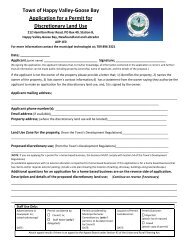Habitat Conservation Plan Habitat Conservation Plan for the Town ...
Habitat Conservation Plan Habitat Conservation Plan for the Town ...
Habitat Conservation Plan Habitat Conservation Plan for the Town ...
- No tags were found...
You also want an ePaper? Increase the reach of your titles
YUMPU automatically turns print PDFs into web optimized ePapers that Google loves.
10 <strong>Habitat</strong> <strong>Conservation</strong> <strong>Plan</strong>Section 4: General Policies <strong>for</strong> Wetland<strong>Conservation</strong>The <strong>Town</strong>’s Commitment to StewardshipIn signing a Municipal Wetland Stewardship Agreement, <strong>the</strong> <strong>Town</strong> has made a publiccommitment to join an international network of important wetland habitat areascontributing to waterfowl presence and abundance in North America. Fur<strong>the</strong>r, <strong>the</strong> <strong>Town</strong>has committed to using this <strong>Conservation</strong> <strong>Plan</strong> as a guide to best management practicesin/around wetlands within its Stewardship Zone(s) and Management Unit(s). It is hopedthat a stewardship ethic will be fostered within <strong>the</strong> community since <strong>the</strong> conservation ofwetlands depends not wholly on <strong>Conservation</strong> <strong>Plan</strong>s or regulations, but on <strong>the</strong>conservation/stewardship ethic of residents and of visitors to <strong>the</strong> <strong>Town</strong>.The Stewardship Zone(s) and Management Unit(s) will be managed to ensure <strong>the</strong>maintenance and possibly enhancement of wetland habitat and waterfowl populations.Managing bodies will include <strong>the</strong> <strong>Town</strong> Council and <strong>the</strong> Department of Environment and<strong>Conservation</strong>, Wildlife Division, through staff of <strong>the</strong> Eastern <strong>Habitat</strong> Joint Venture.Benefits <strong>for</strong> ResidentsThe strategies outlined in this <strong>Habitat</strong> <strong>Conservation</strong> <strong>Plan</strong> can provide many long termrecreational and "quality-of-life" benefits <strong>for</strong> local residents. Wetland habitats are ideallysuited to a variety of consumptive and non-consumptive recreational activities, includingfishing, hiking, photography and bird-watching. The <strong>Town</strong> may wish to use <strong>the</strong>seopportunities to increase tourism to <strong>the</strong> region. In developing recreational and tourismopportunities, careful consideration <strong>for</strong> <strong>the</strong> wildlife populations must be included in <strong>the</strong>planning process. O<strong>the</strong>rwise, human activities may result in negative impacts to <strong>the</strong> veryresource that is providing <strong>the</strong> attraction.Surely <strong>the</strong> most important benefit that people receive from stewardship is <strong>the</strong> opportunityto increase <strong>the</strong>ir knowledge of wetlands and nature in general. Programs such as <strong>the</strong>Wildlife Division’s "Project Wild" foster an increased environmental ethic in youth andadults alike. Many of <strong>the</strong> enhancement and restoration strategies outlined in this <strong>Plan</strong> canbe easily conducted by local community interest groups, <strong>the</strong>reby allowing "hands on"involvement in conservation ef<strong>for</strong>ts.Management of <strong>the</strong> Stewardship ZonesActivities within <strong>the</strong> stewardship zone(s) should be managed on a “sustainable use” or“wise use” basis, whereby permitted activities are implemented so as to minimizeimpacts on wetlands, waterfowl or wildlife populations. Development proposals which,






